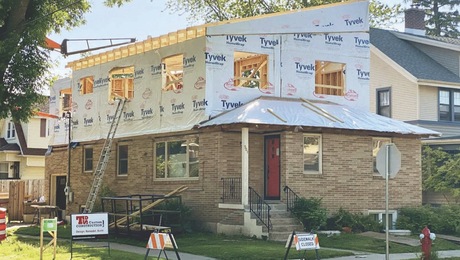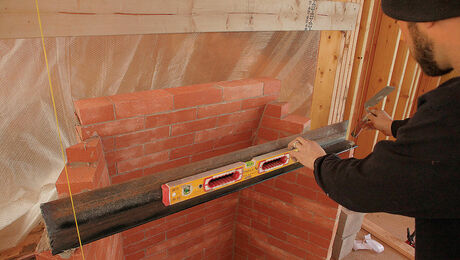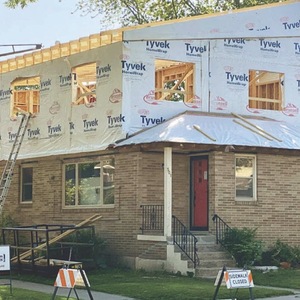My poor sister in law had an addition put on her 1959 vintage home in Southport, Indiana, acutally three separate additions. The local builder states the job is complete but the floors are not level. The addition floors are a good inch higher than the old house. One feels like they are walking up or down hill. The 12×18 tiles in the bath have cracked, through the tile!, and it is clear to me that the walls were not wiped down before the primer as applied as they feel like 60-grit sandpaper.
When asked about the floors, the builder replied, “Oh, if you wanted level floors, you should have said something. That costs extra.”
It has been some months now and the builder continues to jerk her around. It seems to me that customer expections and industry standards dictate level floors, plumb walls, etc. and should not have to be specified.
Am I wrong here? Are our expectations unrealistic? What recourse does she have? I have found nothing in the Code that states floors shall be level.




















Replies
My local radio station has a "call the lawyer" program on weekends. Long before I got into contracting, I was regularly shocked by the tales callers told - tales similar to yours, tales of the most outrageous type.
Then I got to see the other side of the coin- the CUSStomers, who often make their own problems. So many of these nightmares start off with "In order to save money ...." that these days I immediately disregard any suggestions that list 'saving money' as their first advantage.
Why is there always money to 'do it over,' but never money to 'do it right?' Why can folks always find a lawyer, but can't seem to find a real contractor?
Belay that last comment. If folks choose lawyers with the same care they choose contractors ... small wonder the hacks are so plentiful!
If you're not happy, then bite the bullet. Make a detailed list of what you REALLY want. Find another contractor to do it over. Get a contract next time.
John
There are industry standards and one set is listed by architects somewhere (sorry, never had occasion to go look where...........you might try industry standards in carpentry.............) You 'll find the allowable slight variations from perfect (in fractions of inches).
Cracked tile are one way or another not acceptible-especially on new construction (your addition) unless-
The decision for tile was not known prior to commencement of building and of course, if not done by this builder.
your description of his attitude, makes him look bad. Pity that couldn't have been figured out b/4.
Recourse? check with your state consumer rights people and see what they suggest.
Best of luck.
I'd do whatever you can to make trouble for the guy. Complain to whatever authorities you can find, maybe hire a lawyer to recover some of the money.
Certainly don't give the guy any more money.
Though one point is that someone should have advised her that 12x18 tile are a dumb idea in an old house. Unless extraordinary precautions were taken they were guaranteed to crack.
There are two sides to every story and time and time again we hear from folks like you without knowing the whole story.
If the contractor said up front that you probably won't have problems with one type of framing/subfloor/etc. and it's cheaper than option XYZ, and the client has problems every time the client is pissed because somehow the contractor steared them wrong and won't fix it. If someone is working for cheap with the understanding that he's doing the best he can, but can't guarantee anything other than he's doing the best he can and naturally occuring blips in the scedule requiring rework are not going to be done by him for free, then don't expect anything more than that. How are we to know with so little information if what he did, and the reasons for doing it are goofy or not?
Everyone and their sister wants cheap tile and every joe blow will put tile down with basic materials....when the job has cracks who's at fault? Hiring the low bidder using the cheapest materials and expecting miracles is not realistic. There's a reason why the professional tile guy who has great refferences wasn't hired - he's a lot more expensive.
As for floor elevation I'll bet the subfloors are the same height and then tile came up and with cement backing board and tile height it may be close to an inch above thin carpet or vinyl..... If you're saying everyone should build so finished floors are all at the same height I'm saying that's not realistic and simply doesn't happen unless it's clearly stated up front. When I tell clients up front what it costs to lower a floor so everything is level it's more often than not that the client passes on the extra cost, but they still bring it up when everything is finished. More than once I remind them that I brought it up, they declined, had I simply done it without their approval I'd be competing on the bid with guys who lowball everything and probably wouldn't have been their final choice.
As I understand it, with lawsuits in many states, normally the standards put forth by the National Home Builders Association are the yardstick used to judge the work. If you look through them there's a lot of allowable variance from perfection. That's why low cost, low quality building looks like it does and still passes code and whatnot.
Having said all that, if you feel the contractor is being an ass after trying everything else then simply hire an attorny experienced with sueing contractors. At that point what's fair goes out the window and he'll try to screw they guy for everything he can get - that's what lawyers do.
To get some helpful responses you will need to provide a lot more information. For instance: Are the new floors out of level or are they set at a different elevation from the existing? Are the bath tiles in a bathroom that is part of the new addition, or in part of the old house? Have the walls been textured? Some photos would help.
But, in general, I think its not too much to expect that floors be level, walls be plumb, and new materials don't immediately fail. That said, it's also to be expected that this is not a perfect world and in working with an older house, compromise is the order of the day.
Replies to everyone
Thank you all for your inputs. To answer a couple of questions:
1. the new sections are higher than the old and there is a "ramp" from the new to the old.
2. The bathroom floor spans the new and the old. They used Permabase instead of Durock. I suspect that is why the tile failed.
Now some other thoughts:
1. I am alarmed and mystified that builders do not know the Building Codes. Specifically that the Codes are the MINIMUM acceptable practice. We should strive to do better than the Codes, not meet them. Only the cheap, unscrupulous builders stick to the Codes as a way to increase profits.
A good example is the specs table on floor joists. I 2x8 today is 1-1/2"x7-1/4" so does not really meet the specs. So from that point alone we must go up a a notch. Also, live load must be taken into account. Today, Americans are a bunch of lard-asses. You really have to spec a floor for a herd of fat pigs.
Therefore, if a 2x8 is called for, it makes perfect sense to use a 2x12. the floor will not bounce and the occupants will feel more secure.
2. My hackles go up when I hear builders blame the customer. It is not the customer's fault. They don't know anything about this. I am a contractor myself, retired with health issues, and I am forced to hiring contractors simply because I am physically no longer able. I get real upset when a contractor tries to B.S. me. And they all do.
If you explain to the customer--as I have done in the past--what it is you must do to meet or exceed Codes and why it is necessary, 99 times out of a hundred they will go along. I used to ask, "Is cost your only concern?"
If they answered, "Yes", I would give them the name of another contractor.
But then my work used to be yacht carpentry, and I now restrict myself to trim carpentry and furniture. But I do trim work the same way I do furniture, many times using furniture-type joints. and most of my work is custom.
But no matter. If the contractor explains things to the customer, you will have a willing customer who will not complain if you give him what you promised. And alswys give more than you promise.
An acquaintance recently ask me to put in some "country" shelves in a "country" home. country means piece of crap, so I turned it down. I told her, I don't do country.
Another woman asked me to take scraps of red cedar and make her a table for her cabin. I explained to her that my tables start at $2000--at which point she blanced--and told her she could have the red cedar and make her own table. From my shop I am sure she went to the nearst dumpster.
WE are professionals, we don't need that kind of crap.
And we all need turn down jobs that are below us or we know to be strewn with land mines. Do your best work and turn down the crap.
I live by William Morris's creed, "Have nothing in your home unless you know it to be useful or believe it to be beautiful."
"the Codes are the MINIMUM
"the Codes are the MINIMUM acceptable practice."
I've heard that line many times, and I think it's totally BS.
Codes are all over the place. Some are bare minimum. Some are perfectly adequate. And others are ridiculously restrictive.
Saying that they're the minimum is IMHO completely wrong.
John
Codes are applied to nominal sized framing-not the "old" dimensional woods.
So, a 2x8 of a certain species is a 2x8 of that species and it's spec'd accordingly.
I know nothing of the tile underlayment you compare to Durock, so I can't comment on that-
but, cement board is non structural-you either have the subfloor proper and the joists to spec-
or
you don't.
The cement board has nothing to do with it.
After that, no comment other than it's a shame you didn't get involved in the build earlier.
It all starts before the first nail is driven
I'm sorry to here of the difficulties your sister has suffered updating her home. There are still several questions you could answer that could shed some light on the problem and those all started before the contact was awarded to the builder. First is how was builder/contractor found by your sister, from a friend, the architect or some other means. Secondly how much vetting did he go through once he was asked to supply a bid. Did they visits past project s and speak to the clients of those projects. Was an architect used for the project and what was his involvement once it began. How many bids were obtained and where did the final choice fall on the scale. When the bids where reviewed did he provide all requested numbers. Where the other builders given an opportunity to explain there bids and how they arrived at there final costs. I could go on but I think you get the point.
I don't know enough about your situation but I do know construction and what I know is it is an industry full of people that are just out to make a buck no matter what. Or as we like to say, I have no job but I do have a hammer and a truck so I guess I will be a contractor. Currently I am working on a small project fixing/ finishing what a contractor with over 40 yrs experience did not complete after sucking every dime out of the homeowner. He promise the world and left a mess.
Your correct it is not always the homeowners fault and I truly feel for the ones that get taken by the worst of our business but at the end it all started at the beginning.
The average homeowner doesn't think about things like level floors and walls that are plumb, or they'd be going behind the framers with a level and framing square and checking everything. A floor that's an inch out of level is just wrong, I have been in houses like that and the feeling of walking uphill in a room is very annoying. (like the house in the Mystery Spot where water runs uphill) It could have been avoided if the contractor had bothered to put a level on the joists before covering them up. Especially sucks if you're a door hanger or finish carp that has to make everything look and swing right.